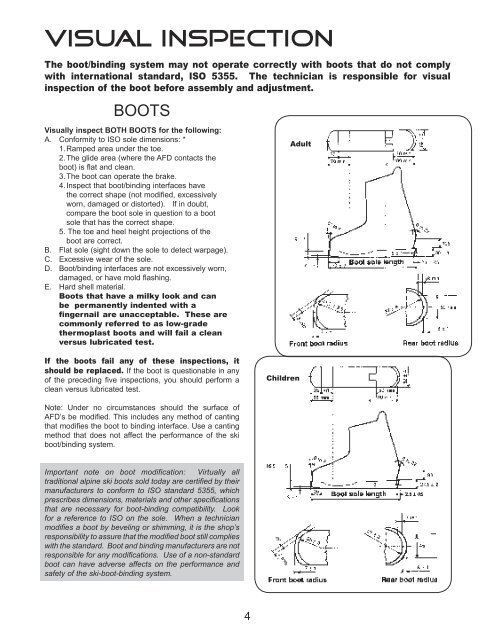rental inspection procedure - Rossignol
rental inspection procedure - Rossignol
rental inspection procedure - Rossignol
You also want an ePaper? Increase the reach of your titles
YUMPU automatically turns print PDFs into web optimized ePapers that Google loves.
VISUAL INSPECTION<br />
The boot/binding system may not operate correctly with boots that do not comply<br />
with international standard, ISO 5355. The technician is responsible for visual<br />
<strong>inspection</strong> of the boot before assembly and adjustment.<br />
BOOTS<br />
Visually inspect BOTH BOOTS for the following:<br />
A. Conformity to ISO sole dimensions: *<br />
1. Ramped area under the toe.<br />
2. The glide area (where the AFD contacts the<br />
boot) is flat and clean.<br />
3. The boot can operate the brake.<br />
4. Inspect that boot/binding interfaces have<br />
the correct shape (not modified, excessively<br />
worn, damaged or distorted). If in doubt,<br />
compare the boot sole in question to a boot<br />
sole that has the correct shape.<br />
5. The toe and heel height projections of the<br />
boot are correct.<br />
B. Flat sole (sight down the sole to detect warpage).<br />
C. Excessive wear of the sole.<br />
D. Boot/binding interfaces are not excessively worn,<br />
damaged, or have mold flashing.<br />
E. Hard shell material.<br />
Boots that have a milky look and can<br />
be permanently indented with a<br />
fingernail are unacceptable. These are<br />
commonly referred to as low-grade<br />
thermoplast boots and will fail a clean<br />
versus lubricated test.<br />
If the boots fail any of these <strong>inspection</strong>s, it<br />
should be replaced. If the boot is questionable in any<br />
of the preceding five <strong>inspection</strong>s, you should perform a<br />
clean versus lubricated test.<br />
Note: Under no circumstances should the surface of<br />
AFD’s be modified. This includes any method of canting<br />
that modifies the boot to binding interface. Use a canting<br />
method that does not affect the performance of the ski<br />
boot/binding system.<br />
Important note on boot modification: Virtually all<br />
traditional alpine ski boots sold today are certified by their<br />
manufacturers to conform to ISO standard 5355, which<br />
prescribes dimensions, materials and other specifications<br />
that are necessary for boot-binding compatibility. Look<br />
for a reference to ISO on the sole. When a technician<br />
modifies a boot by beveling or shimming, it is the shop’s<br />
responsibility to assure that the modified boot still complies<br />
with the standard. Boot and binding manufacturers are not<br />
responsible for any modifications. Use of a non-standard<br />
boot can have adverse affects on the performance and<br />
safety of the ski-boot-binding system.<br />
4<br />
Children<br />
Adult


